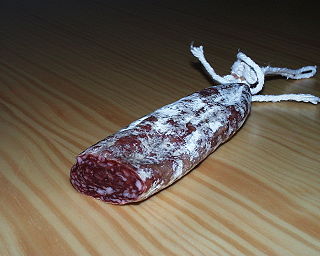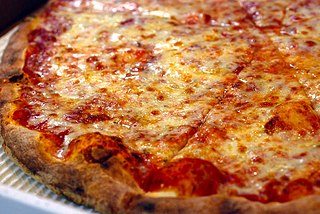
A sausage is a type of meat product usually made from ground meat—often pork, beef, or poultry—along with salt, spices and other flavourings. Other ingredients, such as grains or breadcrumbs, may be included as fillers or extenders.

Hungarian or Magyar cuisine is the cuisine characteristic of the nation of Hungary, and its primary ethnic group, the Magyars. Hungarian cuisine has been described as being the spiciest cuisine in Europe This can largely be attributed to the use of their piquant native spice, Hungarian paprika, in many of their dishes. A mild version of the spice, Hungarian sweet paprika, is commonly used as an alternative. Traditional Hungarian dishes are primarily based on meats, seasonal vegetables, fruits, bread, and dairy products.

Salami is a cured sausage consisting of fermented and air-dried meat, typically pork. Historically, salami was popular among southern, eastern, and central European peasants because it can be stored at room temperature for up to 45 days once cut, supplementing a potentially meager or inconsistent supply of fresh meat. Countries and regions across Europe make their own traditional varieties of salami.

Chorizo is a type of pork sausage originating from the Iberian Peninsula. It is made in many national and regional varieties in several countries on different continents. Some of these varieties are quite different from each other, occasionally leading to confusion or disagreements over the names and identities of the products in question.

Meze is a selection of small dishes served as appetizers in Albanian, Bosnian, Armenian, Kurdish, Levantine, Turkish, Bulgarian, Greek. It is similar to Spanish tapas and Italian antipasti. A mezze may be served as a part of a multi-course meal or form a meal in itself. In non-Islamic countries, or in areas without alcohol restrictions, mezze are often served with spirits such as arak, rakia, raki, oghi or grappa.

Linguiça is a Portuguese sausage made from pork and seasoned with onion, garlic, paprika and other spices. It can be used fresh in cooked preparations or undergo a curing and preservation process through smoking.

Chicago-style pizza is pizza prepared according to several styles developed in Chicago. It can refer to both the well-known deep-dish or stuffed pizzas and the lesser-known thin-crust tavern-style pizzas. The pan in which deep-dish pizza is baked gives the pizza its characteristically high edge, which provides ample space for large amounts of cheese and a chunky tomato sauce. Chicago-style deep-dish pizza may be prepared in the deep-dish style and as a stuffed pizza. Chicago-style thin-crust pizza dough is rolled for a thinner crispier crust than other thin-crust styles. The thin-crust pizza is cut in squares instead of slices, and is also referred to as a "tavern-style" pizza.

Different areas of the world have local variations on the hot dog, in the type of meat used, the condiments added, and its means of preparation.

Longaniza is a Spanish sausage (embutido) similar to a chorizo and also closely associated with the Portuguese linguiça. Its defining characteristics are interpreted differently from region to region. It is popular in the cuisines of several regions of Spain, Argentina, Uruguay, Puerto Rico, Dominican Republic, El Salvador, Guatemala, Mexico and Chile. In the Philippines, it is called longganisa and has hundreds of variants with different vernacular tastes and forms due to the 144 ethno-linguistic groups of the archipelago. Longaniza essentially tracks the spread of Latin culture around the world. Longaniza derives from Lucanica, a sausage from Lucania in Southern Italy that was adopted by the Latins of Ancient Rome through military contact. From there it spread to Spain, and from Spain, centuries later, to every place in the world with modern "Latin" culture.

Hungarian sausages are sausages found in the cuisine of Hungary. Hungary produces a vast number of sui sausage types. They may be boiled, fresh or dried, and smoked, with different spices and flavors, "hot" or "mild". Many were influenced by their neighbors and brethren.

Pizza arrived in the United States in the early 20th century along with waves of Italian immigrants who settled primarily in the larger cities of the Northeast, such as New York, Philadelphia, Boston and Baltimore. After American soldiers stationed in Italy returned from World War II, pizza and pizzerias rapidly grew in popularity.

Regional street food is street food that has commonalities within a region or culture.

Quad City–style pizza is a variety of pizza originating in the Quad Cities region of the states of Illinois and Iowa in the United States.

The traditional cuisine of Abruzzo is eclectic, drawing on pastoral, mountain, and coastal cuisine. Staples of Abruzzo cuisine include bread, pasta, meat, fish, cheese, and wine. The isolation which has characterized the region for centuries has ensured the independence of its culinary tradition from those of nearby regions. Local cuisine was widely appreciated in a 2013 survey among foreign tourists.

Hmong sausage is a long thick pork sausage from Hmong culture seasoned with herbs like lemongrass and Thai chili pepper. The sausage is popular during Hmong New Year celebrations. The exact recipe varies depending on factors such as clan and individual immigration background.

Columbus-style pizza is an American regional pizza style associated with Columbus, Ohio. It has a circular shape, pieces cut into short or long rectangles, thin crust, dense toppings that cover the surface, and, usually, provolone cheese and a slightly sweet sauce. It was developed in the early 1950s.


















